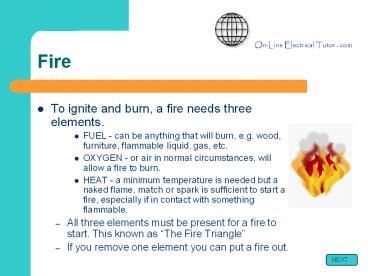Fire To ignite and burn, a fire needs three elements. FUEL - PowerPoint PPT Presentation
1 / 10
Title:
Fire To ignite and burn, a fire needs three elements. FUEL
Description:
Fire To ignite and burn, a fire needs three elements. FUEL - can be anything that will burn, e.g. wood, furniture, flammable liquid, gas, etc. OXYGEN - or air in ... – PowerPoint PPT presentation
Number of Views:127
Avg rating:3.0/5.0
Title: Fire To ignite and burn, a fire needs three elements. FUEL
1
Fire
- To ignite and burn, a fire needs three elements.
- FUEL - can be anything that will burn, e.g. wood,
furniture, flammable liquid, gas, etc. - OXYGEN - or air in normal circumstances, will
allow a fire to burn. - HEAT - a minimum temperature is needed but a
naked flame, match or spark is sufficient to
start a fire, especially if in contact with
something flammable. - All three elements must be present for a fire to
start. This known as The Fire Triangle - If you remove one element you can put a fire out.
2
Reducing fire risk 1
- You can help reduce the risk of fire being
started, or people being harmed if there is a
fire, by - not smoking at work (no smoking areas should be
designated) - maintaining all electrical appliances in a safe
manner - good housekeeping, being tidy
- removing combustible materials outside to a safe
place.
3
Reducing fire risk 2
- Help prevent fires by
- not storing highly flammable liquids unless
essential - disposing of cigarettes carefully
- having clearly marked fire points nearby
- having procedures if there is a fire
4
Reducing fire risk 3
- Help prevent fires by
- putting up signs and notices so people know what
to do - having regular evacuation drills
- keeping fire exits clear
- testing fire alarms frequently.
5
Classes of fire
- Combustible and flammable fuels involved in fires
have been broken down into five categories - Class A fires - are fires
involving organic solids like paper,
wood - Class B fires -are fires
involving flammable liquids - Class C fires -are fires
involving flammable gasses - Class D fires -are fires
involving metals - Class F fires - are fires
involving cooking oils - (Electrical fires have no classification, as
electricity is a source of ignition that will
feed a fire until switched off or isolated.)
6
Which fire extinguisher?
- Never use hose reels, water extinguishers or any
other means of extinguishing with water on - live electrical apparatus
- any fire involving fats, oils or paints
- any metal fire
- anything if there is a risk of electrocution or
explosion. - Different types of fire need a different type of
extinguisher
7
In case of fire
- If a fire does break out, no matter how small
- raise the fire alarm
- call the fire brigade
- close all doors and windows to prevent spread
- leave the building
- always keep between the fire and the way out.
8
Types Of Extinguisher
9
Types Of Extinguisher
10
Fire - summary
- At the end of this presentation you should have
learned that - fire requires three elements fuel, oxygen, heat
- remove one element and the fire will not burn - reduce fire risk in the first place by keeping a
clear and tidy workplace - know the location of your own workplace fire
evacuation procedure - know how to raise the alarm.
- all fire extinguishers are colour coded for the
type of fire on which they can be used

